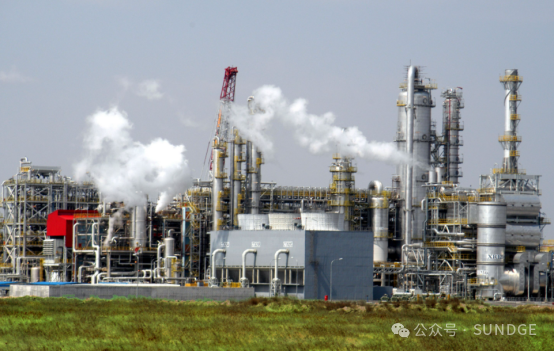DMF
Release time:
2024-06-04
What is N,N-dimethylformamide?
N,N-dimethylformamide (DMF) is a good aprotic polar solvent, which can dissolve most organic and inorganic substances, and is miscible with water, alcohols, ethers, aldehydes, ketones, esters, halogenated hydrocarbons and aromatics. The positively charged end of the N,N-dimethylformamide molecule is surrounded by a methyl group, forming a spatial barrier that prevents the negative ions from approaching, but only associates the positive ions. The activity of exposed negative ions is much greater than that of solvated negative ions. For example, the reaction of carboxylates with halogenated hydrocarbons in N,N-dimethylformamide at room temperature can generate high-yield esters, which are particularly suitable for the synthesis of steric hindered esters.

Production process:
After the methanol is gasified, the reaction temperature is 220 °C on the composite catalyst with copper as the main body (the amount relative to the methanol is 1wt%), and the pressure is atmospheric, catalytic dehydrogenation to generate methyl formate, and then amination reaction with dimethylamine is carried out to obtain crude products N,N-dimethylformamide and methanol, and the crude product is refined to obtain high-purity N,N-dimethylformamide.

Uses of Dimethylformamide:
In the polyurethane industry, it is used as a washing and curing agent, mainly used in the production of wet synthetic leather; It is used as a solvent in the acrylic fiber industry, mainly used in the dry spinning production of acrylic fiber;
In the electronics industry, it is used as the quenching of tinned parts and the cleaning of circuit boards; Other industries include carriers of hazardous gases, solvents for the crystallization of pharmaceuticals, adhesives, etc. In organic reactions, dimethylformamide is not only widely used as a solvent for reactions, but also an important intermediate in organic synthesis.


It can be used in the pesticide industry to produce insecticides; In the pharmaceutical industry, it can be used to synthesize iodidine, doxycycline, cortisone, vitamin B6, iodoside, cortisone, thiazimone, N-formylsarcomin, antineomorine, methoxyaromatic mustard, nitrogen mustard, cyclohexylnitrosis, fufluuracil, hemostatic cyclic acid, bememetsone, megestrolone, cholevita, chlorpheniramine, sulfonamides.
Dimethylformamide has a catalytic effect in the reaction of hydrogenation, dehydrogenation, dehydration and dehalogenation, which reduces the reaction temperature and improves the purity of the product.
Properties of dimethylformamide:
Acute toxicity: LD50: 400mg/kg (rat oral); 5000mg/kg (rabbit transdermal). LC50: 9400mg/m3, 2h (mouse inhalation). People inhaled 30~60ppm, gastrointestinal symptoms, abnormal liver function, jaundice, increased urobilinogen, proteinuria; People inhale 10~20ppm (sometimes 30ppm), headache, loss of appetite, nausea, normal liver function and electrocardiogram.
Subacute and chronic toxicity: rats inhaled 2500mg/m3, 6h/d, 5d, 80% died, liver and lung lesions; After inhaling 5.1~49mg/m3 for × 3 years, neurasthenia syndrome, low blood pressure and liver function changes appeared. Metabolism: After N,N-dimethylformamide (DMF) is absorbed by various pathways, it is mainly metabolized by the liver and excreted quickly, and the main target organ is the liver, and the kidneys are also damaged to a certain extent. It is mainly demethylated by intrahepatic microsomal mixed functional oxidase, and a methyl group is removed, and the metabolites are monomethylformamide and formamide, which are rapidly metabolized; Formamide remains in the blood for a little longer and is metabolized to formic acid and ammonia for excretion. Partial dimethylformamide is excreted in the urine and exhalation in its original form.
Health hazards: irritating effects on the eyes, skin and respiratory tract. Vapors can cause mild to moderate irritation of the eyes and upper respiratory tract. Contaminated skin can cause mild and severe burns, wrinkled skin, pale complexion, accompanied by burning sensation, and in severe cases, it can make the skin swollen and swelling, and severe burning pain. polluted eyes cause burning, lacrimation, conjunctival injection; In severe cases, corneal necrosis can occur. Gastrointestinal symptoms: patients often have loss of appetite, nausea, vomiting, abdominal discomfort and constipation, and a few cases have mid-upper abdominal pain.
Liver: Liver damage is often prominent during acute poisoning, patients have obvious fatigue, right upper abdominal distension and pain, discomfort, jaundice, gradual enlargement of the liver, tenderness, routine liver function tests show abnormalities, among which the increase in serum aminotransferases is more obvious. The lesions are usually not severe, but can be gradually reduced with treatment, and the disease can recover completely within a few weeks. Severe acute poisoning: manifested as severe toxic liver disease, occupational poisoning is rare, exposure to high concentrations, especially serious skin pollution, not washed in time and thoroughly, should be alert to serious poisoning. Emergency response
Emergency Response:
Treatment principle: Leave the scene, take off the contaminated clothing, and rinse with water immediately when the skin is contaminated. There is no specific antidote, mainly to protect the liver. Symptomatic treatment, such as hemorrhagic gastroenteritis.
Adrenal corticosteroids may be used in severely poisoned patients. Precautionary measures: The production process is as closed as possible, and local suction and exhaust gas recovery are strengthened. When the equipment is maintained, the gas mask should be used reasonably. Contact between this product and concentrated lye should be avoided to avoid the production of another poison - dimethylamine. Hazard classification (GB5044-85): Level III (moderate hazard).
RELATED NEWS
Copyright © Nanjing Shundajie Chemical New Materials Co., Ltd. Powered by www.300.cn











